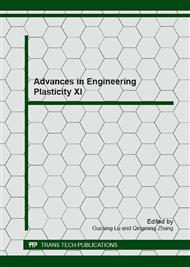p.547
p.553
p.557
p.561
p.565
p.569
p.574
p.578
p.582
Investigation on the Damage Process and the Deformation of Concrete Using Meso Element Equivalent Method
Abstract:
The meso-element equivalent method (MEEM), is developed in the study to investigate the damage process and the macro-mechanical properties of concrete. The Monte Carlo method is adopted to generate the random aggregate structure (RAS) firstly, and then the characteristic element size is applied to divide the RAS into many identical units. Each unit obtained is processed equivalently to be a homogeneous and isotropic unit by the homogenization theory. Some concrete specimens in 2-D and 3-D are undertaken to verify the feasibility and accuracy of the proposed approach. The results indicate the high efficiency and accuracy of the present methodology.
Info:
Periodical:
Pages:
578-581
Citation:
Online since:
January 2013
Authors:
Price:
Сopyright:
© 2013 Trans Tech Publications Ltd. All Rights Reserved
Share:
Citation:


